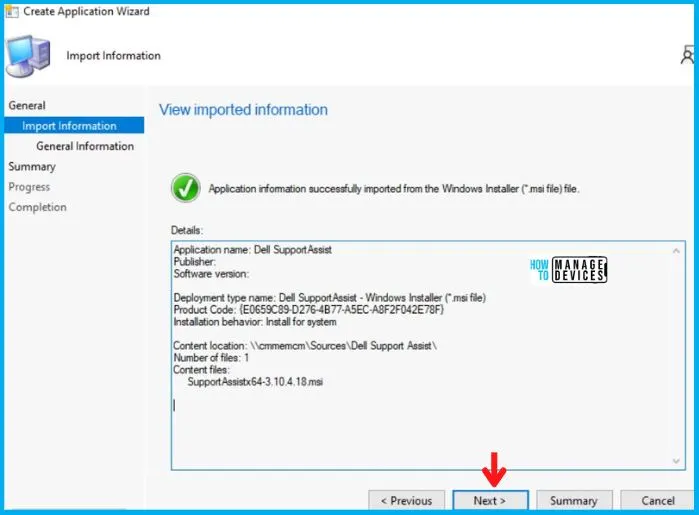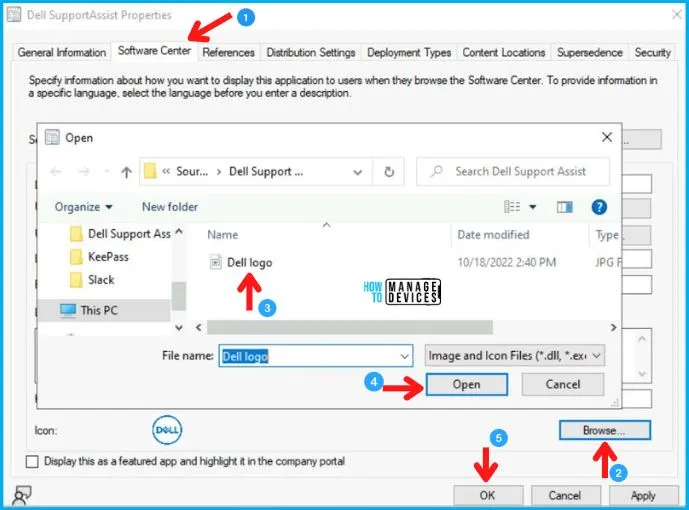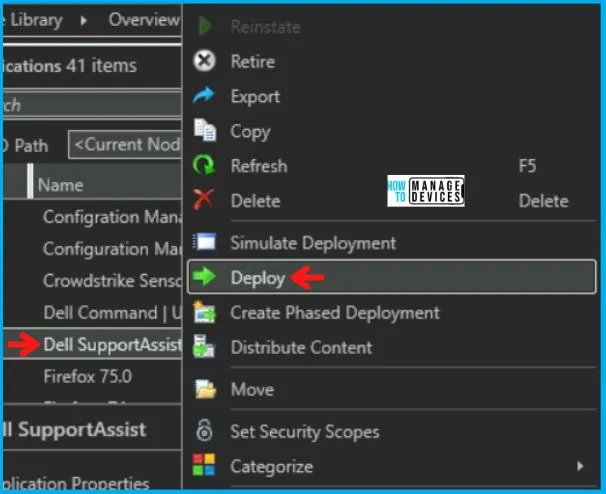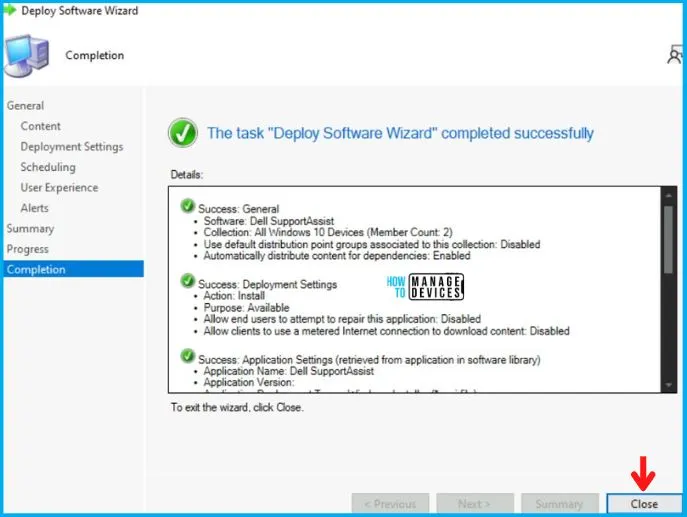Hello Everyone !!! Here we come again with another post. in this post you will go through the Dell SupportAssist Deployment Using SCCM. In this post, we will deploy Dell SupportAssist on the client machines using System Center Configuration Manager.
You can use the Dell SupportAssist tool to update drivers and the system BIOS. This tool can help you troubleshoot issues with your devices. Dell SupportAssist is the smart technology that keeps your PC running like new.
SupportAssist automatically detects and proactively alerts Dell to operating system issues, software upgrades, driver updates and patches, malware, virus-infected files, failures of hard drives, batteries, memory, internal cables, and more.
Most Dell PCs with Windows 10 come with SupportAssist installed. The program can be found in the Start Menu by searching for “SupportAssist”. SupportAssist automatically scans your PC for driver and Dell application updates. If an update is available, you will be notified proactively.
The MSI application is the best method to deploy the Dell SupportAssist to Windows 10/11 devices. In this Step-by-Step guide for Dell SupportAssist Application Deployment using SCCM, we will use the MSI file for the deployment.
- Deploy KeePass using SCCM | Step-By-Step Guide
- Apple iTunes Deployment using SCCM MSI Application Model
What is an MSI file?
Windows packages that contain installation information, including files to be installed and installation locations, are called MSI files. The EXE and MSI files both install and launch Windows programs.
The EXE file may not always contain an installer and may launch its program when double-clicked. An MSI file, however, always includes an installer.
- Detect Registry Changes and Revert using SCCM Configuration Item CI CB
- SCCM CI to find Windows 11 Device is Blocked from an Upgrade
Dell SupportAssist Deployment Using SCCM
Let’s start with the Deployment of Dell SupportAssist using SCCM. As told earlier, we are using the MSI file for Dell SupportAssist Deployment. You will see why the availability of MSI files for any application brings sparkles in the eyes of the SCCM Admin.
Here we don’t need to work on prerequisites as we used to tell you in the previous posts in which we used EXE files.
- All we have to do is download the MSI installer and the logo of Dell SupportAssist, as we know it is available for download, and our half job is done.
One can easily download the 64-bit application directly from Dell SupportAssist (Dell recommends to download the package from TechDirect) They have provided different setups for different environments. One can easily differentiate and choose the right setup for the Windows 64-bit architecture.
The following table gives you all the details required for the Dell SupportAssist Deployment tool using SCCM. This includes the command line for Dell SupportAssist silent install, Uninstall, and Product Code.
| Name | Install Command Line | Uninstall Command Line | Detection Method |
|---|---|---|---|
| Dell SupportAssist Deployment Tool – Windows Installer (*.msi file) | Install -> msiexec /i “SupportAssistx64-3.10.4.18.msi” /q | Uninstall -> msiexec /x {E0659C89-D276-4B77-A5EC-A8F2F042E78F} /q | Windows Installer – {E0659C89-D276-4B77-A5EC-A8F2F042E78F} |
Dell SupportAssist Application Creation Using SCCM Console
This MSI application deployment guide will use the SCCM admin console to create an application. To start with the Application creation part, copy the downloaded setup to the package source location of the SCCM Server.
- Navigate to SCCM Console\Software Library\Overview\Application Management\ Applications.
- Right-click on Applications and select Create Application.

For all MSI application deployments, always Select the Automatically detect Information about the application from installation files and choose Windows Installer (.msi files) in the Type category. Also, enter the UNC Path for the application in Location and click Next as shown below in the image.

Now you will see the real Magic!!! As soon you click on next, you will see that all the information has been imported from the MSI file as shown below, and click Next.

Also in the General Information Tab shown below, you will see it imports the install behavior/command (msiexec /i “SupportAssistx64-3.10.4.18.msi” /q) from the installer itself.
- Silent Command Line for Dell SupportAssist = msiexec /i “SupportAssistx64-3.10.4.18.msi” /q

After this, click Next on the Summary Tab and end this Create Application Wizard by clicking on Close in Completion Tab.

After the creation of the Application, it will appear in the Application Node. Now to Add an Icon to the Dell SupportAssist, right-click on the Dell SupportAssist and click on Properties.
After this choose Software Center Tab as shown below. And click on Browse in Icon, select the icon, and click on Apply and OK, as shown in the image below.

Distribute Dell SupportAssist Application to the DP
After the creation of the Application, it will appear in the Application Node. To begin with, the distribution right-clicks on the Dell SupportAssist Application and clicks on Distribute Content, as shown in the picture below.

Now the Distribute Content Wizard will open, and click Next in the General Tab. Then select the Application Name in the Content Tab and Click on Next, as shown in the image below.

After this, in the Content Destination Tab, Click on Add and select the Distribution Point option.

Then Add Distribution Point page will pop up, choose the Distribution Point on which you want to distribute the Application and click on OK, and then on Next.

After this, Click Next on Summary Tab and complete this Distribution process by clicking Close on Completion Tab.

Deploy Dell SupportAssist using SCCM
So as of now, we have accomplished two tasks i.e., Application Creation and Application Distribution to the DP. Now all that is left is the Deployment of the Dell SupportAssist on the All Windows 10 Device Collection.
- As you can see, your Application is displaying in Application Node, Right-click on Dell SupportAssist and select Deploy.

After this, Deploy Software Wizard opens, and in the General Tab, enter the Name of the Application and click on Browse to select the Collection.

Now the Select Collection page will pop up; choose Device Collection from the drop-down menu, and then
- Select your targeted Device Collection and click on OK, and then Next.
- Here I choose All Windows 10 Devices.

Now in the Deployment Settings Tab, select:
- Install in the Action box
- And choose Available in the Purpose category.

In the Scheduling Tab, enter the time details if you want it to be available at a specific time; otherwise, leave it as it is and click Next. After this, in the User Experience Tab,
- Select Display in Software Center and shows all notification options in the User
- Select Display in Software Center and shows all notification options in the User notifications, and click on Next as shown below.

In the Alerts and Summary Tab, click on Next and to end the process, click on Close in the Completion Tab.

Time to Check Windows 11 Client Machine
In this section, we will check the end-user experience for Dell SupportAssist Application Deployment and Installation. The Dell SupportAssist Application is Created, Distributed, and Deployed.
Now, if you check the Software Center of Win 10 device from the Windows 10 Device (or All Windows 11 Device) Collection, you will see the Application in Available Mode, and the user can install it as per the requirement.

As you can see in the below screenshot, the Dell SupportAssist Application is installed successfully on Windows 10/11 devices. This proves that the above MSI installer works fine for Dell SupportAssist Application Installation using SCCM.

So the above picture depicts that we have finally created, Distributed, Deployed, and Installed the Dell SupportAssist Application as shown in the Software Center as shown in the above image.
Author
Abhinav Rana is working as an SCCM Admin. He loves to help the community by sharing his knowledge. He is a BTech graduate in Information Technology.

The link for downloading is invalid. Kindly update.
The link provided to download is old and invalid.
Please update it.
I think you need to download it from Dell’s Tech Direct – https://tdm.dell.com/portal